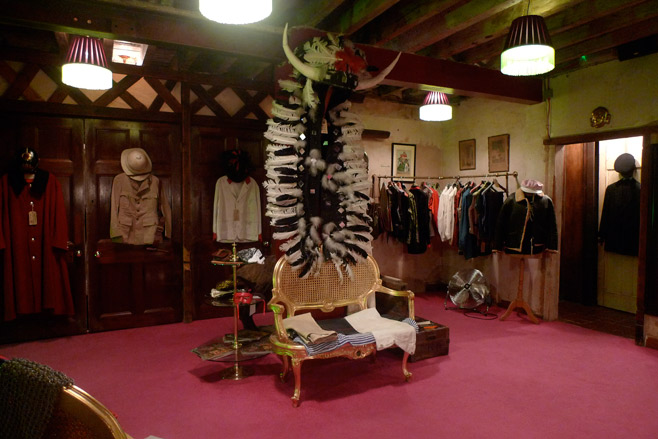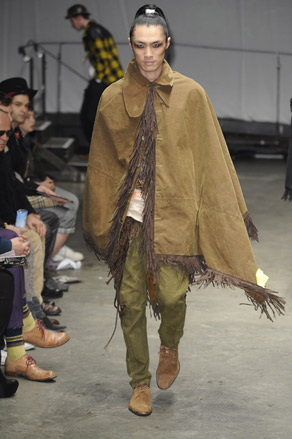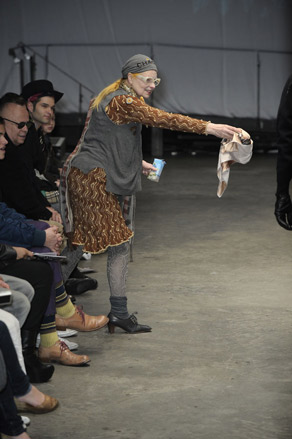Joe Corre: A Child of the Jago?

Considering his heritage, it comes as no surprise that Joe Corre recently founded his second major fashion label in some 15 years. The progeny of Dame Vivienne Westwood and Malcolm McLaren, Corre recently deserted Agent Provocateur – the international lingerie label he founded in the mid 90s - and has since established his first menswear line, A Child of the Jago.
Unveiling the brand’s second collection at an intimate show during last week’s London Fashion Week, Corre – along with creative partner Simon ‘Barnzley’ Armitage – has played down the press on his new project, claiming he wanted to start Jago ‘inconspicuously, and let it shine on
its own merit’.
The collection, a mixture of antique pieces – harking as far back as the Napoleonic era – fashion house off-cuts and immaculately tailored items, A Child of the Jago comes billed as ‘A child of the street - the destitute and illegitimate progeny of a hopelessly rundown environment’.
Alongside its London Fashion Week outing, 'A Child of the Jago' will also be represented at a one-off pop-up shop, on location in Selfridges for the next five weeks.
We caught up with Corre during preparations for his Fashion Week showcase and found out more about this season’s ‘Monkeyrama’ collection; what it was like growing up with Westwood for a mother and whether Corre himself really is, A Child of the Jago.
This is your second season for ‘A Child of the Jago’, tell us a little about the collection.
Well, we’re calling the collection ‘Monkeyrama’. It’s based around a series of Victorian etchings by Thomas Landseer, which feature monkeys dressed as men. In a wider sense, the collection is based around the same concept as the company itself. We source materials made obsolete by the fashion industry, and transform them into things people - from the knife sharpener to the boot shiner - would have worn in the slums of East London, making them a little more durable and dandy along the way.
How would you say your work at ‘A Child of the Jago’ relates to what you’ve achieved with Agent Provocateur?
Agent Provocateur became too corporate and boring in the end. But I suppose, in a way, the two relate, in that Agent Provocateur was born out of a passion for doing something different. Apart form going to my mother’s shop or to a tailor, I found menswear distinctly unexciting. How many black suits do you want? Even pieces I loved from my mother’s shows wouldn’t get made because they weren’t ‘commercial’ enough, which I found hugely frustrating. I just found menswear really boring and decided to do something about it.
Wallpaper* Newsletter
Receive our daily digest of inspiration, escapism and design stories from around the world direct to your inbox.
The media coverage of ‘A Child of the Jago’ has been minimal, is this what you intended?
I opened the shop quietly to see if I could make something work on its own merit. It started in a very organic way. The reason we’re showing at London Fashion Week is because we’ve got one of the most interesting menswear lines out there. At Agent Provocateur I started with one shop in Soho, which made a statement. I’m doing the same thing with this, although I don’t have the same intention to expand. Tailors make everything and it’s all constructed from material off-cuts - expansion wouldn’t fit with the company - my ambition is not to become a low-cost outlet for people from the fashion industry.
Do you think your punky, East-London heritage has much to do with what you’re doing at ‘A Child of the Jago’?
Absolutely, everyone’s past informs what they do. My parents had shops that were inspirational and defined an era and I grew up understanding that. My parents communicated ideas through retail; their shops were more than just sales platforms. Since Agent Provocateur I’ve realized that the nineties was an era defined by brands – to the point that Agent Provocateur was bought by a bank last year! A Child of the Jago, on the other hand, is about celebrating individualism in an interesting and sexy way.
How did your collaboration with Simon ‘Barnzley’ Armitage come about? Have you worked together before?
We’d done bits and pieces together in the past, we worked on a brand called ‘Activist’ for a while. When I was growing up and going to clubs and helping my mum in World’s End in the 1980s, Barnzley and I used to go out together, live together and run wild together – and we always tried to out dress each other. Barnzley was working on his own thing and not really enjoying it, and I was fed up with menswear, so we decided to do something that inspired us.
‘A Child of the Jago’ is staunchly anti-disposability, from where does this concern arise and how do you put it into practice with the collections?
We buy antique clothes from the Napoleonic wars through to the Victorian era - pieces way beyond ‘vintage’ – and mix them with other amazing bits of really high quality, disposed-of materials to make beautiful things we can then sell at a reasonable price. Our stuff is amazing quality and looks a million times better than stuff you can get on the high street. You won’t look like a cookie cutter person wearing ‘A Child of the Jago’.
How important is a sense of narrative in your ‘A Child of the Jago’ collections?
I suppose the strongest sense of narrative comes through in the show itself. In terms of the clothes, Barnzley and I share exactly the same points of reference. We remember those things that looked crap and those things that didn’t. We’ve combined our ‘style histories’ and created a new way of communicating through clothes.
Do you see yourself as a child of the Jago?
I found the book (A Child of the Jago) incredibly charming. It’s all about a little boy living in the ‘jago’ surrounded by characters whose only way out of the slum was either in a coffin, or as a criminal – and the criminals loved to dress up. I suppose the book is about a little boy exposed to the pomp of Victorian London whilst living in an utter hole – and whilst I don’t think of myself like that - I do identify with having the entire establishment against you, and feeling absolutely OK about it.
There’s an innate ‘London-ness’ to everything - from the clothes to the store – do you see LFW as an important platform from which to show the collection?
To be honest, I’m really not interested in this brand joining the fashion treadmill. We want to show collections when we want to show them. I’ve watched my mother do the show rounds for years and I absolutely do not want to do that. We’ve had two shows thus far, and I don’t think we’ll do one next season. We want to have a few outlets, from which we can feed stuff regularly to customers. Not just in two big seasonal lumps.
Lingerie to men’s tailoring is a big jump, what else is in store for Joe Corre?
We’re going to add a womenswear line for sure once we’ve opened in the West End. But not right now – as soon as we’re settled in we’ll definitely be thinking about it.

Joe Corre's flagship 'A Child of the Jago' store in Shoreditch, East London.

Last week's London Fashion Week show was Corre's second collection for the fledgling brand.

Entitled 'Monkeyrama', the show took inspiration from a series of etchings by Thomas Landseer, which feature monkeys dressed as men.

Joe Corre conspired with creative partner, Simon 'Barnzley' Armitage, to come up with the concept for the show.

The collection features a mixture of antique pieces – harking as far back as the Napoleonic era – fashion house off-cuts and immaculately tailored items.

Corre and his creative partner Simon 'Barnzley' Armitage take a bow at the close of the show.

As if in proof of her son's impressive sartorial credentials, Vivienne Westwood takes to the runway mid-show.

'A Child of the Jago' is Corre's first solo project since his departure from international lingerie label, Agent Provocateur.

The man himself, Joe Corre.
ADDRESS
A Child of the Jago
10 Great Eastern Street
London
EC2A 3NT
-
 Extreme Cashmere reimagines retail with its new Amsterdam store: ‘You want to take your shoes off and stay’
Extreme Cashmere reimagines retail with its new Amsterdam store: ‘You want to take your shoes off and stay’Wallpaper* takes a tour of Extreme Cashmere’s new Amsterdam store, a space which reflects the label’s famed hospitality and unconventional approach to knitwear
By Jack Moss
-
 Titanium watches are strong, light and enduring: here are some of the best
Titanium watches are strong, light and enduring: here are some of the bestBrands including Bremont, Christopher Ward and Grand Seiko are exploring the possibilities of titanium watches
By Chris Hall
-
 Warp Records announces its first event in over a decade at the Barbican
Warp Records announces its first event in over a decade at the Barbican‘A Warp Happening,' landing 14 June, is guaranteed to be an epic day out
By Tianna Williams